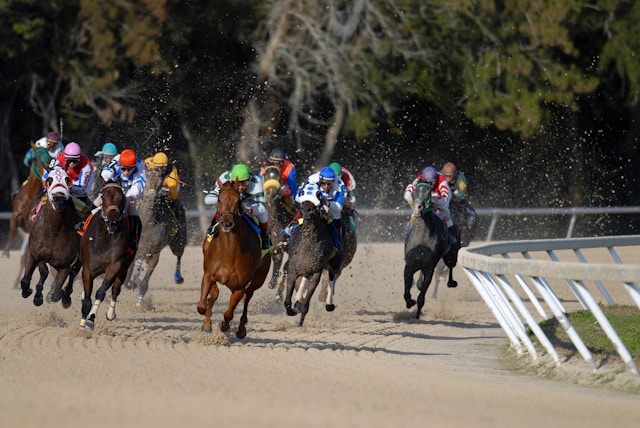In a country full of sports enthusiasts, certain sports dominate the spotlight, while many others struggle to break into the mainstream, fighting for recognition, resources, and opportunities to showcase their talent and build a dedicated following. However, one sport has been the talk of the town for centuries in India and continues to rise with each passing year.
Horse racing in India has been capturing the attention of prominent figures and the general public for the past 250 years. Only for the Elite back in the days, this intriguing sport was introduced to India by Britishers in 1777. The new era for sports in India began with its very first horse racing event on the grounds of Guindy Race Course, Madras (Now known as Chennai), making a historical mark and establishing a tradition that is celebrated to this day.
In the light of this fascinating “Sport of Kings” was founded the first and the oldest horse racing club of South Asia in 1837, widely renowned as the Madras Race Club. The sport, once known to be exclusive to the royalties, sparked a wave of inquisitiveness and became an integral part of the culture, intertwining with its roots. The establishment of the Madras Race Club kick started the evolution of horse racing with various new and improved race courses and race clubs.
In the year 1875 the operations of the Madras Race Club were brought to a standstill due to the visit of the Prince of Wales. However, they were revived again in 1887 by Lt. Col. George Moore, President of the Corporation of Madras. The year 1896 was the time when a new and refined form of Madras Race Club was brought to existence in order to manage and rectify the assets and liabilities of the earlier form of organization. When all the obstacles were thought to vanished leaving a path as clear as the sky, first world war stepped in to once again halt the operations of Madras Race Club, which were later revived by the efforts of the Governor, Lord Willingdon in 1919. A proper structure of the organization was finally formed in 1931.
Shortly after the birth of MRC, the Royal Calcutta Turf Club came into being in 1847 and took over the Kolkata Race Course, built in 1820, that hosts races from the month of July to September and then again from November to the month of march. RCTC witnessed its largest crowd for the first time during the Royal visit of King George V and Queen Mary to attend the race for the King’s Cup. Mr Glastaun’s Brogue clinched the first position in the grand contest and was awarded the King’s cup by the King himself.
All the race courses used to follow the old and most important classic races after their name, including the Derby, the Oaks, the One Thousand Guineas, the Saint Leger, and the Two Thousand Guineas.
Founded in 1883, the Royal Western India Turf Club, popularly known as Mahalaxmi Race Course in Mumbai hosted the first major horse racing event in 1943, known as The Indian Derby, won by PRINCESS BEAUTIFUL owned by HH The Maharaja Gaekwar of Baroda, trained by M. C. Patel and ridden by Jockey E. Britt.
The RWITC also governs the Pune Race Course which was built in 1830 and highlights the Pune Derby, The RWITC Gold Cup, Independence Cup, Southern Command Cup and many more.
The environment of Bangalore- such as the climate, terrain and possible other factors was conducive to breeding of horses suitable for equestrian pursuit. The breeding of horses to attain the requisite skills in the sport, later led to the formation of Bangalore Turf Club in 1920. BTC has played a significant role in the evolution of horse racing in India by producing superior quality horses, particularly thoroughbreds. However, it also made its contribution during world war II by raising funds and contributing them to Madras Mail War Plane Fund through the Mysore State War Relief Fund.
Though horse racing in Mysore dates back to 1891, the Mysore Race Club was officially formed in 1951. The organisation consisting of 25 members was established by the Bangalore Turf Club. The Mysore Race Club was the first race club in India to employ Dr. (Miss) Vasanthi Ishwaraiah- a Lady Veterinary Officer – as an official, in the year 1981. The club also allowed the first lady trainer- Miss. Diana Craig Jones to be part of the race as a professional. These, one of the many instances, glorified the existence of the Mysore Race Club.
Hyderabad Turf Club is one of the six major turf authorities in India and the youngest among them. The club was established in 1961. However, the tradition of horse racing in the legendary land of fabulous Nizams, dates back to 1868. The HRC is the only organization out of the six Indian turf authorities to possess the entire race course complex, including the tracks, stands, professional quarters, stables, parking lot and more.
Among one of the oldest race clubs in northern India, is Delhi Race Club, formed in 1926. The club holds a unique place in the horse racing industry due to the shape of its track. Originally, the track was oval-shaped, but later, a portion was taken over by the Indian Air Force, resulting in the unique horseshoe shape.








